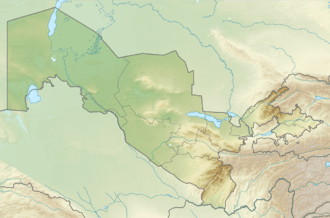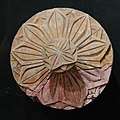Kara Tepe
Kara Tepe is a Buddhist archaeological site in the Central Asia region of Bactria, in the Termez oasis near the city of Termez in southern Uzbekistan.[1][2][3] The foundations of the site date to the 1st century CE, with a peak of activity around the 3rd and 4th centuries during the Kushan period, before experiencing a fatal decline around the 5th century CE, probably with the invasion of the Kushano-Sassanian, whose coinage can be found on the site.[1]


Site
The site of Kara Tepe is located on a slight height, a few hundred meters from Fayaz Tepe. The site is formed some outdoor constructions together with several caves dug in the hill, covering a surface of 7 hectares, in a type similar to those seen in Gandhara.[1] It is the only troglodyte group found in Central Asia. This Buddhist complex is located on military ground and is generally inaccessible.
 North court
North court Genral view, northern area
Genral view, northern area Inside a cave
Inside a cave
Artefacts
Many niches were found that sheltered sculptures of gold or ceramic Buddhas, and awnings rested on impressive colonnades.[1] Remarkably, some of the Buddha statues are surrounded by a full halo, which became current in Turkestan and East Asia after the Kushan period.[1][2] A Brahmi inscription was also recovered from the site.[4]
 Terracotta head (200-400 CE)
Terracotta head (200-400 CE) Relief (200-400 CE)
Relief (200-400 CE)_200-400_CE.jpg) Terracotta head
Terracotta head Frieze of an elephant
Frieze of an elephant Lid of a pot
Lid of a pot "Greek" column base
"Greek" column base
See also
References
| Wikimedia Commons has media related to Kara Tepe. |
- Dani, Ahmad Hasan; Litvinovskiĭ, Boris Abramovich (1999). History of Civilizations of Central Asia. Motilal Banarsidass Publ. p. 549-550. ISBN 978-81-208-1540-7.
- Rhie, Marylin Martin (2010). Early Buddhist Art of China and Central Asia, Volume 3: The Western Ch’in in Kansu in the Sixteen Kingdoms Period and Inter-relationships with the Buddhist Art of Gandhāra. BRILL. p. 34. ISBN 978-90-04-19019-1.
- Muzio, Ciro Lo. The Legacy of Gandhāra in Central Asian Painting". p. 116.
- Hinüber, Oskar von (1980). A Brahmi-inscription from Kara-Tepe.

.jpg)